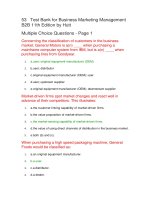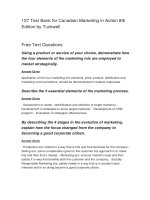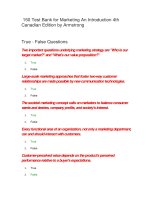Test bank for maternity nursing revised reprint 8th edition by lowdermilk
Bạn đang xem bản rút gọn của tài liệu. Xem và tải ngay bản đầy đủ của tài liệu tại đây (389.21 KB, 32 trang )
Link download full: Test Bank for Maternity Nursing Revised Reprint 8th
Edition by Lowdermilk
CLICK HERE
Chapter 08: Maternal and Fetal Nutrition
MULTIPLE CHOICE
1. A 22-year-old woman pregnant with a single fetus has a preconception
body mass index (BMI) of 24. When she was seen in the clinic at 14
weeks of gestation, she had gained 1.8 kg (4 lb) since conception. How
would the nurse interpret this?
a.
This weight gain indicates possible
gestational hypertension.
b.
This weight gain indicates that the
woman’s infant is at risk for intrauterine
growth restriction (IUGR).
c.
This weight gain cannot be evaluated until
the woman has been observed for several
more weeks.
d.
The woman’s weight gain is appropriate
for this stage of pregnancy.
ANS: D
Feedback
A
Although this is an accurate statement, it
does not apply to this patient. The
desirable weight gain during pregnancy
varies among women. The primary factor
to consider in making a weight gain
recommendation is the appropriateness of
the pre-pregnancy weight for the woman’s
height. A commonly used method of
evaluating the appropriateness of weight
for height is the BMI. This woman has
gained the appropriate amount of weight
for her size at this point in her pregnancy.
B
Although this is an accurate statement, it
does not apply to this patient. The
desirable weight gain during pregnancy
varies among women. The primary factor
to consider in making a weight gain
recommendation is the appropriateness of
the pre-pregnancy weight for the woman’s
height. A commonly used method of
evaluating the appropriateness of weight
for height is the BMI. This woman has
gained the appropriate amount of weight
for her size at this point in her pregnancy.
C
Weight gain should take place throughout
the pregnancy. The optimal rate of weight
gain depends on the stage of the
pregnancy.
D
This is an accurate statement. This
woman’s BMI is in the normal range.
During the first trimester, the average total
weight gain is only 1 to 2.5 kg.
DIF: Cognitive Level: Analysis
REF: 243
OBJ: Client Needs: Health Promotion and Maintenance
Process: Assessment
TOP: Nursing
2. Which of the following meals would provide the most absorbable iron?
a.
Toasted cheese sandwich, celery sticks,
tomato slices, and a grape drink
b.
Oatmeal, whole wheat toast, jelly, and
low-fat milk
c.
Black bean soup, wheat crackers,
ambrosia (orange sections, coconut, and
pecans), and prunes
d.
Red beans and rice, cornbread, mixed
greens, and decaffeinated tea
ANS: C
Feedback
A
Food sources that are rich in iron include
liver, meats, whole grain or enriched
breads and cereals, deep green leafy
vegetables, legumes, and dried fruits.
Dairy products are not a source of iron.
B
Food sources that are rich in iron include
liver, meats, whole grain or enriched
breads and cereals, deep green leafy
vegetables, legumes, and dried fruits.
Dairy products are not a source of iron.
C
Food sources that are rich in iron include
liver, meats, whole grain or enriched
breads and cereals, deep green leafy
vegetables, legumes, and dried fruits. The
foods in this meal are all good sources of
iron. In addition, the vitamin C in ambrosia
(orange sections) aids absorption.
D
Food sources that are rich in iron include
liver, meats, whole grain or enriched
breads and cereals, deep green leafy
vegetables, legumes, and dried fruits. Tea
is not a source of iron.
DIF: Cognitive Level: Comprehension REF: 241
OBJ: Client Needs: Physiologic
Integrity
TOP: Nursing Process: Planning
3. Which nutrient’s recommended dietary allowance (RDA) is higher during
lactation than during pregnancy?
a.
Energy (kcal)
b.
Iron
c.
Vitamin A
d.
Folic acid
ANS: A
Feedback
A
Needs for energy, protein, calcium, iodine,
zinc, the B vitamins, and vitamin C remain
greater during lactation than during
pregnancy.
B
Needs for energy, protein, calcium, iodine,
zinc, the B vitamins, and vitamin C remain
greater during lactation than during
pregnancy.
C
Needs for energy, protein, calcium, iodine,
zinc, the B vitamins, and vitamin C remain
greater during lactation than during
pregnancy.
D
Needs for energy, protein, calcium, iodine,
zinc, the B vitamins, and vitamin C remain
greater during lactation than during
pregnancy.
DIF: Cognitive Level: Knowledge
OBJ: Client Needs: Physiologic
Integrity
REF: 252
TOP: Nursing Process: Planning
4. A pregnant woman experiencing nausea and vomiting should:
a.
Drink a glass of water with a fat-free
carbohydrate before getting out of bed in
the morning.
b.
Eat small, frequent meals (every 2 to 3
hours).
c.
Increase her intake of high-fat foods to
keep the stomach full and coated.
d.
Limit fluid intake throughout the day.
ANS: B
Feedback
A
A pregnant woman experiencing nausea
and vomiting should avoid consuming
fluids early in the day or when nauseated.
B
This is a correct suggestion for a woman
experiencing nausea and vomiting.
C
A pregnant woman experiencing nausea
and vomiting should reduce her intake of
fried and other fatty foods.
D
A pregnant woman experiencing nausea
and vomiting should avoid consuming
fluids early in the morning or when
nauseated but should compensate by
drinking fluids at other times.
DIF: Cognitive Level: Comprehension REF: 259
OBJ: Client Needs: Physiologic
Integrity
TOP: Nursing Process: Planning
5. Which statement made by a lactating woman would lead the nurse to
believe that the woman might have lactose intolerance?
a.
“I always have heartburn after I drink milk.”
b.
“If I drink more than a cup of milk, I usually
have abdominal cramps and bloating.”
c.
“Drinking milk usually makes me break out
in hives.”
d.
“Sometimes I notice that I have bad breath
after I drink a cup of milk.”
ANS: B
Feedback
A
One problem that can interfere with milk
consumption is lactose intolerance, which
is the inability to digest milk sugar because
of a lack of the enzyme lactose in the
small intestine. Milk consumption may
cause abdominal cramping, bloating, and
diarrhea in such people, although many
lactose-intolerant individuals can tolerate
small amounts of milk without symptoms.
B
These symptoms are consistent with
lactose intolerance.
C
One problem that can interfere with milk
consumption is lactose intolerance, which
is the inability to digest milk sugar because
of a lack of the enzyme lactose in the
small intestine. Milk consumption may
cause abdominal cramping, bloating, and
diarrhea in such people, although many
lactose-intolerant individuals can tolerate
small amounts of milk without symptoms.
D
One problem that can interfere with milk
consumption is lactose intolerance, which
is the inability to digest milk sugar because
of a lack of the enzyme lactose in the
small intestine. Milk consumption may
cause abdominal cramping, bloating, and
diarrhea in such people, although many
lactose-intolerant individuals can tolerate
small amounts of milk without symptoms.
DIF: Cognitive Level: Application
OBJ: Client Needs: Physiologic
Integrity
REF: 247
TOP: Nursing Process: Assessment
6. A pregnant woman’s diet history indicates that she likes the following list
of foods. The nurse would encourage this woman to consume more of
which food to increase her calcium intake?
a.
Fresh apricots
b.
Canned clams
c.
Spaghetti with meat sauce
d.
Canned sardines
ANS: D
Feedback
A
Apricots are not high in calcium.
B
Canned clams are not high in calcium.
C
Spaghetti with meat sauce is not high in
calcium.
D
Sardines are rich in calcium.
DIF: Cognitive Level: Comprehension REF: 248
OBJ: Client Needs: Physiologic
Integrity
TOP: Nursing Process: Planning
7. A 27-year-old pregnant woman had a preconceptual body mass index
(BMI) of 18.0. The nurse knows that this woman’s total recommended
weight gain during pregnancy should be at least:
a.
20 kg (44 lb).
b.
16 kg (35 lb).
c.
12.5 kg (27.5 lb).
d.
10 kg (22 lb).
ANS: C
Feedback
A
This weight gain would be unhealthy for
most women. This woman has a normal
BMI and should gain 11.5 to 16 kg during
pregnancy.
B
This is the high end of the range of weight
this woman should gain in her pregnancy.
C
This woman has a normal BMI and should
gain 11.5 to 16 kg during pregnancy.
D
This weight gain would be appropriate for
an obese woman. This woman has a
normal BMI, which indicates that her
weight is average.
DIF: Cognitive Level: Comprehension REF: 243
OBJ: Client Needs: Health Promotion and Maintenance
Process: Planning
TOP: Nursing
8. A woman in week 34 of pregnancy reports that she is very
uncomfortable because of heartburn. The nurse would suggest that the
woman:
a.
Substitute other calcium sources for milk
in her diet.
b.
Lie down after each meal.
c.
Reduce the amount of fiber she
consumes.
d.
Eat five small meals daily.
ANS: D
Feedback
A
Eliminating milk in the diet is an
inappropriate dietary suggestion for all
pregnant women, and it does not alleviate
heartburn.
B
Lying down after meals may actually
increase the symptoms of heartburn.
C
Reducing the amount of dietary fiber
consumed is not likely to alleviate
heartburn.
D
Eating small, frequent meals may help with
heartburn, nausea, and vomiting.
DIF: Cognitive Level: Comprehension REF: 259
OBJ: Client Needs: Physiologic
Integrity
TOP: Nursing Process: Planning
9. A woman has come to the clinic for preconception counseling because
she wants to start trying to get pregnant in 3 months. She can expect
the following advice:
a.
“Discontinue all contraception now.”
b.
“Lose weight so that you can gain more
during pregnancy.”
c.
“You may take any medications you have
been taking regularly.”
d.
“Make sure that you include adequate folic
acid in your diet.”
ANS: D
Feedback
A
Depending on the type of contraception
used, this may not be an accurate
statement.
B
This statement is not appropriate advice.
C
Depending on the type of medication the
woman is taking, this may not be an
accurate statement.
D
A healthy diet before conception is the
best way to ensure that adequate nutrients
are available for the developing fetus. A
woman’s folate or folic acid intake is of
particular concern in the periconception
period. Neural tube defects are more
common in infants of women with a poor
folic acid intake.
DIF: Cognitive Level: Application
REF: 240
OBJ: Client Needs: Health Promotion and Maintenance
Process: Planning
TOP: Nursing
10.
To prevent gastrointestinal upset, patients should be instructed to
take iron supplements:
a.
On a full stomach.
b.
At bedtime.
c.
After eating a meal.
d.
With milk.
ANS: B
Feedback
A
Iron supplements are best absorbed if they
are taken when the stomach is empty. Iron
can be taken at bedtime if abdominal
discomfort occurs when it is taken
between meals.
B
Taking the iron supplement at bedtime is
helpful in reducing gastrointestinal
discomfort.
C
Iron supplements are best absorbed if they
are taken when the stomach is empty. Iron
can be taken at bedtime if abdominal
discomfort occurs when it is taken
between meals.
D
Iron supplements are best absorbed if they
are taken when the stomach is empty.
Bran, tea, coffee, milk, and eggs may
reduce absorption.
DIF: Cognitive Level: Application
OBJ: Client Needs: Physiologic
Integrity
REF: 247
TOP: Nursing Process: Planning
11.
Pregnant adolescents are at high risk for _____ because of lower
body mass indices (BMIs) and “fad” dieting.
a.
Obesity
b.
Diabetes
c.
Low-birth-weight babies
d.
High-birth-weight babies
ANS: C
Feedback
A
Obesity is associated with higher BMIs.
Adolescents typically have a lower BMI
because they are still developing and they
may follow unsafe nutritional practices.
B
Diabetes is associated with higher BMIs,
or obesity. Adolescents typically have a
lower BMI because they are still
developing and they may follow unsafe
nutritional practices.
C
Adolescents tend to have lower BMIs. In
addition, the fetus and still-growing mother
appear to compete for nutrients. These
factors, along with inadequate weight gain,
lend themselves to a higher incidence of
low-birth-weight babies.
D
High-birth-weight babies are frequently
associated with women who have
gestational diabetes or obesity.
Adolescents typically have a lower BMI,
because they are still developing and they
may follow unsafe nutritional practices.
DIF: Cognitive Level: Application
REF: 252
OBJ: Client Needs: Health Promotion and Maintenance
TOP: Nursing Process: Assessment, Diagnosis
12.
Which statement about acronyms in nutrition is accurate?
a.
Dietary reference intakes (DRIs) consist of
RDAs, adequate intakes (AIs), and upper
limits (ULs).
b.
Recommended dietary allowances (RDAs)
are the same as ULs, except with better
data.
c.
AIs offer guidelines for avoiding excessive
amounts of nutrients.
d.
They all refer to green, leafy vegetables;
whole grains; and fruit.
ANS: A
Feedback
A
DRIs consist of RDAs, AIs, and ULs. AIs
are similar to RDAs, except that they deal
with nutrients about which data are
insufficient for certainty (RDA status). ULs
are guidelines for avoiding excesses of
nutrients for which excess is toxic. Green,
leafy vegetables; whole grains; and fruit
are important, but they are not the whole
nutritional story.
B
DRIs consist of RDAs, AIs, and ULs. AIs
are similar to RDAs, except that they deal
with nutrients about which data are
insufficient for certainty (RDA status). ULs
are guidelines for avoiding excesses of
nutrients for which excess is toxic. Green,
leafy vegetables; whole grains; and fruit
are important, but they are not the whole
nutritional story.
C
DRIs consist of RDAs, AIs, and ULs. AIs
are similar to RDAs, except that they deal
with nutrients about which data are
insufficient for certainty (RDA status). ULs
are guidelines for avoiding excesses of
nutrients for which excess is toxic. Green,
leafy vegetables; whole grains; and fruit
are important, but they are not the whole
nutritional story.
D
DRIs consist of RDAs, AIs, and ULs. AIs
are similar to RDAs, except that they deal
with nutrients about which data are
insufficient for certainty (RDA status). ULs
are guidelines for avoiding excesses of
nutrients for which excess is toxic. Green,
leafy vegetables; whole grains; and fruit
are important, but they are not the whole
nutritional story.
DIF: Cognitive Level: Knowledge
OBJ: Client Needs: Physiologic
Integrity
REF: 240
TOP: Nursing Process: Assessment
13.
With regard to protein in the diet of pregnant women, nurses
should be aware that:
a.
Many protein-rich foods are also good
sources of calcium, iron, and B vitamins.
b.
Many women need to increase their
protein intake during pregnancy.
c.
As with carbohydrates and fat, no specific
recommendations exist for the amount of
protein in the diet.
d.
High-protein supplements can be used
without risk by women on macrobiotic
diets.
ANS: A
Feedback
A
Good protein sources such as meat, milk,
eggs, and cheese have a lot of calcium
and iron.
B
Most women already eat a high-protein
diet and do not need to increase their
intake.
C
Protein is sufficiently important that
specific servings of meat and dairy are
recommended.
D
High-protein supplements are not
recommended because they have been
associated with an increased incidence of
preterm births.
DIF: Cognitive Level: Knowledge
REF: 241
OBJ: Client Needs: Physiologic
Integrity
14.
TOP: Nursing Process: Planning
Which nutritional recommendation about fluids is accurate?
a.
A woman’s daily intake should be eight to
10 glasses (2.3 L) of water, milk, and/or
juice.
b.
Coffee should be limited to no more than 2
cups, but tea and cocoa can be consumed
without worry.
c.
Of the artificial sweeteners, only
aspartame has not been associated with
any maternity health concerns.
d.
Water with fluoride is especially
encouraged because it reduces the child’s
risk of tooth decay.
ANS: A
Feedback
A
Eight to 10 glasses is the standard for
fluids; however, they should be the right
fluids.
B
All beverages containing caffeine,
including tea, cocoa, and some soft drinks,
should be avoided or drunk only in limited
amounts.
C
Artificial sweeteners, including aspartame,
have no ill effects on the normal mother or
fetus. However, mothers with
phenylketonuria should avoid aspartame.
D
No evidence indicates that prenatal
fluoride consumption reduces childhood
tooth decay. However, it still helps the
mother.
DIF: Cognitive Level: Comprehension REF: 245
OBJ: Client Needs: Physiologic
Integrity
TOP: Nursing Process: Planning
15.
Which vitamins or minerals can lead to congenital malformations
of the fetus if taken in excess by the mother?
a.
Zinc
b.
Vitamin D
c.
Folic acid
d.
Vitamin A
ANS: D
Feedback
A
Zinc is vital to good maternity and fetal
health but is highly unlikely to be
consumed in excess.
B
Vitamin D is vital to good maternity and
fetal health but is highly unlikely to be
consumed in excess.
C
Folic acid is vital to good maternity and
fetal health but is highly unlikely to be
consumed in excess.
D
Vitamin A taken in excess causes a
number of problems. An analog of vitamin
A appears in prescribed acne medications,
which must not be taken during
pregnancy.
DIF: Cognitive Level: Comprehension REF: 249
OBJ: Client Needs: Health Promotion and Maintenance
Process: Planning
TOP: Nursing
16.
While taking a diet history, the nurse might be told that the
expectant mother has cravings for ice chips, cornstarch, and baking
soda. This represents a nutritional problem known as:
a.
Preeclampsia.
b.
Pyrosis.
c.
Pica.
d.
Purging.
ANS: C
Feedback









